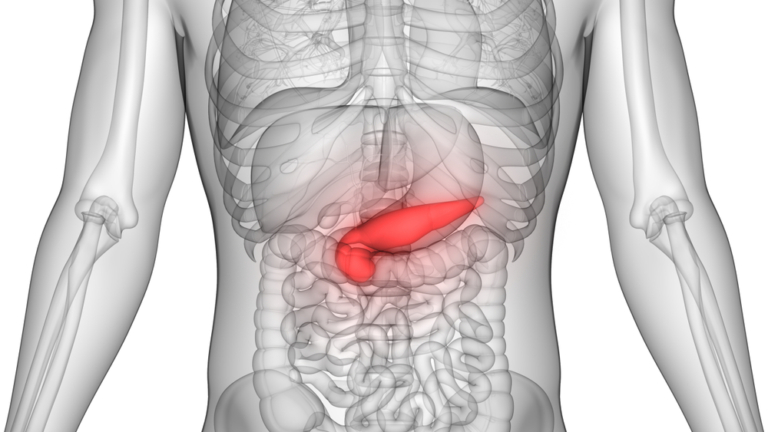What is a Pancreatic Cyst
A pancreatic cyst is a fluid-filled pocket that grows in the pancreas – a glandular organ located behind the stomach. The pancreas produces hormones that help regulate blood sugar levels, and aids the digestive system by secreting pancreatic juice and digestive enzymes.
What percentage of pancreatic cysts are cancerous? 1-2 percent of pancreatic cysts are cancerous.
While the majority of pancreatic cysts are benign, some are precancerous and have the potential to develop into pancreatic cancer.An accurate diagnosis is crucial for determining the best course of action.
DocPanel is committed to making sure every patient receives excellent care. If you would like an expert second opinion on your medical imaging from one of our fellowship-trained subspecialty radiologists, you can learn more here.
How is a Pancreatic Cyst Detected?
Most pancreatic cysts are asymptomatic and are discovered incidentally during abdominal imaging tests for an unrelated reason. Ultrasound, CT, and MRI are the most commonly used imaging modalities to detect and evaluate the type and stage of a pancreatic cyst.
Differentiation between the type of pancreatic cyst, as well as the ability to determine its potential to be cancerous, requires the expertise of a subspeciality radiologist with extensive experience in managing pancreatic lesions.
Diagnosing a Cyst on Pancreas
Improvements in medical imaging have led to a notable increase in the diagnosis of pancreatic cysts. While most cysts on the pancreas are benign, some have the potential to turn into cancer. Determining the nature and type of a pancreatic cyst is challenging and requires the expertise of a subspecialist.
To distinguish a precancerous pancreatic cyst from a benign cyst, follow-up imaging tests are often required. Location, size, and the presence of any solid components are key factors used to determine the type of a pancreatic cyst.
CT Scan – Helpful in evaluating the size and structure of a pancreatic cyst. Best modality for picking up calcification of a pancreatic cyst.
MRI Scan – Provides a closer look at the internal structure of a cyst; usually the preferred modality to evaluate the nature of the cyst.
Endoscopic Ultrasound – A complementary test to further evaluate the nature of a cyst; also provides a method for fluid collection to test for cancer cells.
In the case of a small benign pancreatic cyst, evaluation is particularly difficult. Regular follow-up and monitoring is advised.
CONNECT WITH A SPECIALIST
Take Charge of Your Health
Get a second opinion from a radiology specialist in 3 easy steps.
Types of Pancreatic Cysts
There are many types of pancreatic cysts. Below are some of the most common forms:
Pseudocysts
Primarily made of fluid, a pancreatic pseudocyst can develop in or beside the pancreas. They are commonly associated with pancreatitis.
Pancreatic pseudocysts are the most common type of pancreatic cysts, accounting for approximately 75% of all pancreatic masses.
Serous Cystadenomas (SCAs)
Almost all serous cystadenoma pancreatic cysts are benign. They have thick, fibrous walls and contain clear fluid.
Intraductal Papillary Mucinous Neoplasms (IPMNs)
Intraductal papillary mucinous neoplasms are the most common type of precancerous pancreatic cyst. They generally form inside the ducts that connect the pancreas to the intestine. Because IPMNs produce proteins that form mucus within the cyst’s lining, it’s difficult to predict if and when it will become cancerous.
Mucinous Cystic Neoplasms (MCNs)
Mucinous cystic neoplasms are precancerous pancreatic cysts that usually occur in the tail of the pancreas. This type of pancreatic cyst is most commonly found in middle-aged women.
Common Causes of Pancreatic Cysts
The most common cause of benign (non-cancerous) pancreatic cysts is pancreatitis – inflammation of the pancreas, most commonly a result of excessive alcohol use or gallstone disease. In some cases, however, a cyst on the pancreas may develop for no apparent reason.
How Do You Treat A Pancreatic Cyst
For the majority of patients, a benign pancreatic cyst does not require any treatment. Imaging tests such as a CT scan, MRI, or endoscopic ultrasound may be used to monitor the cyst. In some cases, when the cyst is causing pain or discomfort, a clinician may recommend surgical removal. Because pancreatic cysts and pancreatic pseudocysts can develop serious complications, such as infection, they should be monitored regularly. .
Most of the time, a cyst on the pancreas does not need treatment. However, because pancreatic cysts are so complex to diagnose, patients with this condition are often at risk for overtreatment. Image interpretation by a subspecialty radiologist can help ensure accuracy and reduce the chance of misdiagnosis.
The best treatment for cancerous and precancerous pancreatic cysts is surgical removal. Operations are typically minimally invasive procedures.
Get a Subspecialty Second Opinion Today
The DocPanel platform enables people all over the world to get an expert second opinion in as little as 24 – 72 hours.
An easy 3-step process – instantly upload your scans, select an expert subspecialty radiologist (or have DocPanel assign your case to the appropriate subspecialist), and submit your request. Upon uploading your scans, you’ll also have the opportunity to ask any questions you might have about your case.
Not sure what a subspecialist is? Learn more with our in-depth article on the importance of getting a second opinion from a subspecialty radiologist.
Dr. Richard Semelka, leading expert in abdominal imaging, has been practicing radiology for over 28 years. He’s written over 16 text-books, 370 peer-reviewed papers, and has over 21,000 research citations in Abdominal Imaging.
Get your scans interpreted by Dr. Semelka or explore DocPanel’s complete team of subspecialty radiologists. Request a second opinion today.
